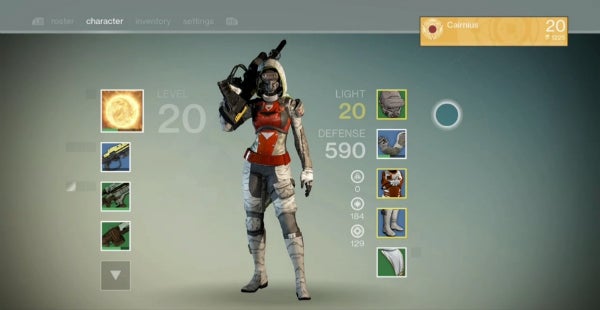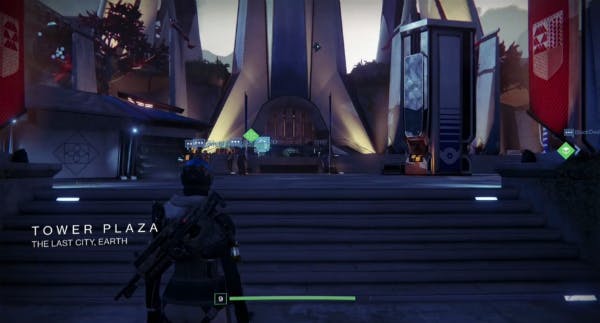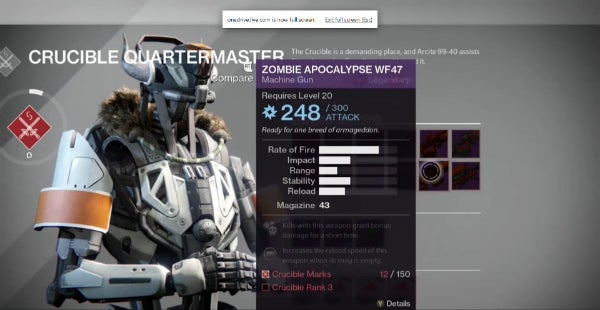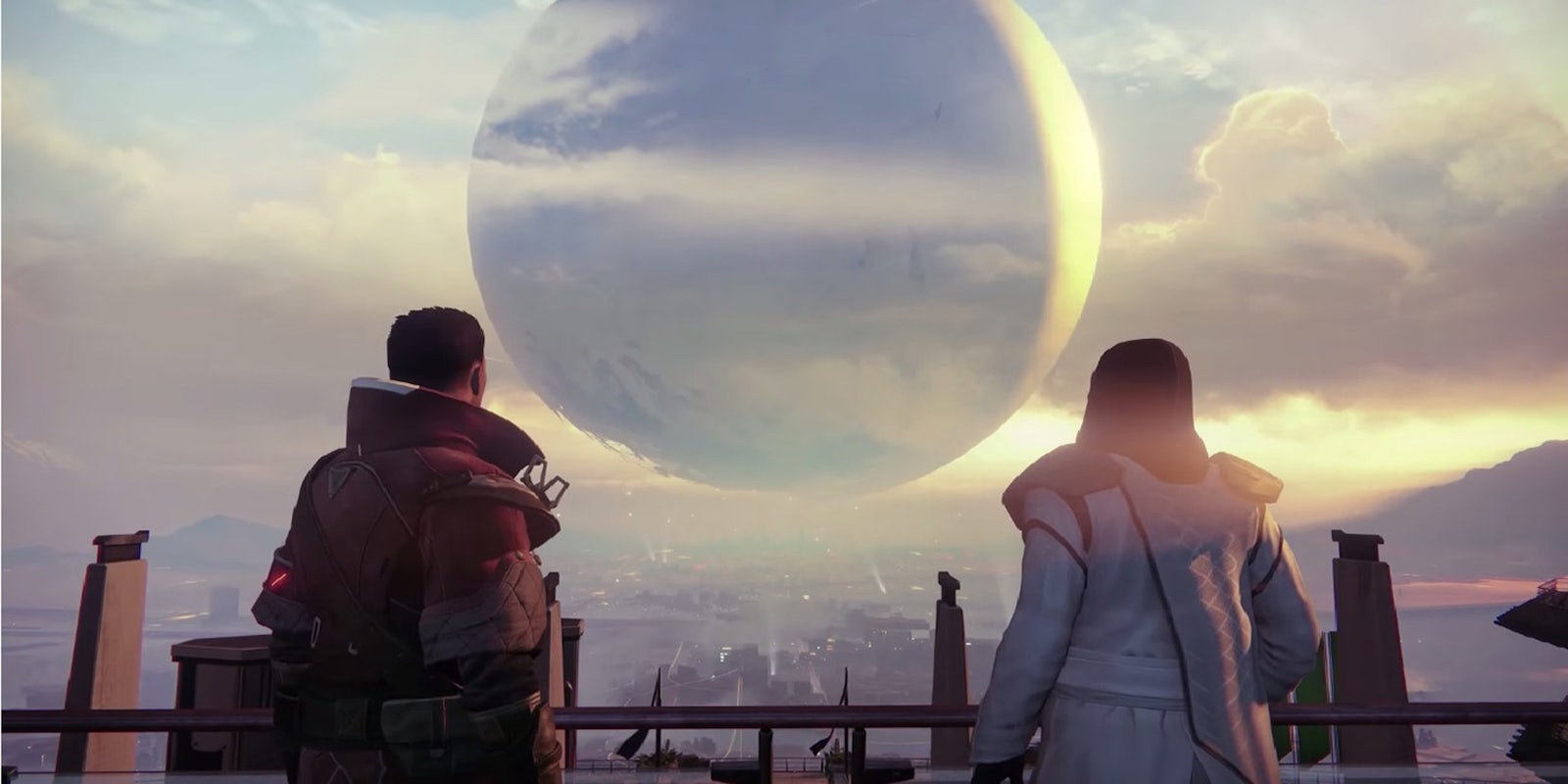Warning: This review contains massive spoilers for Destiny.
If any studio other than Bungie had released such a bait-and-switch as Destiny, critics and gamers alike would be losing their minds.
The cooperative shooter at the heart of Destiny is great fun, supported by superlative production values. Destiny is the first game I’ve played that demonstrates the power of the Xbox One and PlayStation 4. Destiny looks amazing on both systems.
But a cooperative shooter is not all Destiny wants to be. It also wants to be a role-playing game, but has no characters and no story. It wants to be a massively multiplayer online game, but doesn’t allow players to communicate with one another in any meaningful way.
Destiny borrows just enough from both genres to support an endgame built on recycling spent content over and over again. As a business proposition, Destiny is conceptually brilliant. As a video game, it cuts so many corners in pursuit of supporting its endgame that it feels unfinished and, in some cases, downright sloppy.
Because, in the end, what you do in this screen is all that really matters in Destiny.

Destiny takes place hundreds of years after humanity was saved from extinction by a cosmic being called the Traveler. What is left of the human race, after an assault by aliens who are somehow connected to an evil force called “the Darkness,” huddles under the Traveler’s husk.
Players take the role of Guardians, knight-errants who wield the the power of the Traveler. Guardians break down into different classes roughly defined by their role in combat. They can arm themselves with a variety of different weapons and armor that provides protection and stat bonuses, all in the style of role-playing games.
The Guardians are accompanied by little floating artificial intelligences, called Ghosts, which are voiced by Peter Dinklage of Game of Thrones fame. The quality of Dinklage’s voice acting is pretty low across the board, but I would lay that more on the material and/or lack of adequate direction than on deficiency of talent.
The first quarter of the story takes place on Earth, where a race of six-armed space pirates called the Fallen are picking away at the bones of the Cosmodrome, a launching site in Old Russia for colony ships in the days before the Darkness almost destroyed humanity.
Players form up into three-man Fireteams to tackle a handful of story missions spread across the large Cosmodrome map. They can also take on Patrols, which are mini-missions set throughout the map, and riding jetbikes called Sparrows while out on Patrol is also a lot of fun.
The game feels like Borderlands at this point. You and your friends cooperate to kill bad guys, earn experience points and money, and pick up loot in the form of new weapons and armor. The game is mostly about improving the power and equipment of your characters, to be able to tackle more difficult missions coming down the pike.
In addition to all the regular missions, there is also a Strike, a longer mission that involves killing a pair of powerful Boss enemies by beating on them incessantly until they die. The Strike in Old Russia feels a lot like this:
You discover an alien race called the Hive are infesting the Cosmodrome. The second quarter of the game takes place on the Moon, where the Hive are massing an invasion force. They’ve built a huge underground temple, littered with the bones of millions of dead humans, and are breeding monstrosities to finish us off. You’re handed another set of story missions, and Patrol missions, and things keep on in the Borderlands style, which is awesome.
Then you get to Venus. If there is a single map in Destiny that holistically defines the quality of Bungie’s art department, it’s Venus. Bungie creates a lush jungle world defined by azure blues, shocking yellows, and neon greens.
The aesthetic juxtaposition on Venus between the fantastic and the modern is compelling. In the ruins of what looks like a contemporary human city—rusting wrecks of automobiles and old subway transit map kiosks being reclaimed by the Venusian swamp—you can see the conceptual genius of what Bungie had in mind with Destiny’s universe.
Then the chinks in Destiny’s armor begin to show. After a pitched battle against a race of machines called the Vex, whose individual enemy types are named after fantasy monsters like Goblins, and Minotaurs, and Harpies, we see this cutscene:
The writing is horrible. There’s actually no relationship between players and their Ghosts reflective of that final exchange. I set aside my negative reaction, in the hopes that the next cutscene would be better.
Then I went to the Reef, a collection of space flotsam that somehow houses a race of people named the Awoken, and I paid a visit to their Queen.
After 10 hours’ worth of Destiny presenting itself as a cooperative multiplayer shooter a la Borderlands, now it was trying to pass itself off as a single-player RPG. These cutscenes are clearly aping the sort of fare you’d find in Dragon Age or Mass Effect.
RPGs hinge their appeal on characters, however. There is no “player character” in Destiny in a narrative sense. The players inhabit what for all intents and purposes are precisely the same sort of mute protagonists they inhabited in the Halo series.
I have no idea who this Queen is, or why she has some pet Fallen, and nothing about that will ever be explained to me, even after I go to Venus and slay the Gate Lord as commanded, and return to the Queen.
Bungie is clearly playing off fantasy tropes. These scenes are “the visit to the Elves,” something that ought to be recognizable to any Lord of the Rings fan. Our heroes make an appeal for aid to a group of mysteriously aloof and powerful beings who barely deign themselves to meddle in the affairs of men.
I understand why Bungie is doing all of this: To reinforce the idea that Destiny is actually an epic adventure, and to shore up the way we’re meant to relate to Destiny, in part, as an RPG. But there are all sorts of mistakes made here, from the perspective of an RPG fan.
One of the three races a player can choose for his or her character in Destiny is an Awoken, the race of people living on the Reef. I have friends who are playing Awoken characters. Wouldn’t those characters know precisely where they were going, and who they would be speaking to, when they head out for this audience with the Queen? My friends playing Awoken reported no such thing.
Why does my character appear alone in these scenes if Destiny is a game built around three-man Fireteams? Aren’t I supposed to be on some sort of epic adventure with a pair of companions? Why does Destiny abruptly cease to be a cooperative multiplayer affair and turn into a single-player RPG at all?

I had, throughout the entire playthrough thus far, been similarly confused about the way the Tower is designed. The Tower is a social hub on Earth where players will frequently return between missions. At the Tower, players turn in quests, pick up new equipment, and get to see a bunch of other Destiny players all around them, which creates the illusion of being in a living, breathing world.
The Tower is akin to a hub city in an MMORPG, a common area where hundreds of players gather. There are usually several such hubs spread throughout an expansive MMO world. Destiny only has the Tower, and it’s a neutered social hub at best.
For instance, in an MMO, players usually communicate via a chat window, located by default in the lower left-hand corner of the screen. The Xbox One and PlayStation 4 don’t ship with keyboards, of course, but the Xbox consoles can link up to Smartglass on smartphones and tablets, which provide keyboard functionality. And the PlayStation 4 can handle Bluetooth and USB peripherals, so it’s conceivable Bungie could have provided a chat function had it wanted to.
Instead, all players can do is call up a roster of who is with them in the Tower and invite others to a Fireteam. That’s it. The best players can do in terms of open communication in the Tower is waving and pointing and dancing, which means that socially the Tower is pretty much only good for moments like these:
So why is the Tower, an MMO-ish space that doesn’t offer a proper MMO environment, even there? Why not have a unique instance of the Tower for individuals or their Fireteams, like Borderlands has a central hub town that fulfills all the same purposes?
The answers to all of my questions as to why Destiny is using these seemingly vestigial design elements were provided when I leveled my character up to 20, and finished the paper-thin wisp of a story. Once you’ve done all of this, Destiny becomes an entirely different game.
Once you hit level 20, your character stops leveling in the traditional manner, i.e. through accrual of experience points. To level up your character, you have to equip armor that has a new characteristic, called Light. The system is barely explained to the player, such that anyone who wants to figure out how to keep leveling up will probably need to look up help guides online.
One way to get this new armor is via very rare loot drops. Another way is to try and get armor with Light as a reward for player-versus-player activities. The more reliable way to get those armor pieces is to purchase them from Crucible or Vanguard vendors.
The Crucible is Destiny’s multiplayer portion, and it’s quite punishing. Players take all their powers and gear with them into the Crucible, so unless your character is leveled up and well-equipped, you are at a severe disadvantage.
When you complete matches in the Crucible, you earn Crucible reputation points, and Crucible Marks. You use the reputation points to increase your standing with the Crucible vendor, which eventually unlocks Crucible armor and weapons that are purchased with Crucible Marks.
If you aren’t skilled at multiplayer FPS gaming, your other option is to purchase items with Light from Vanguard vendors. You earn Vanguard reputation points and Marks by running Strike missions, And each Strike mission is something you’ve already done, if you’ve completed the “story.” Again, Strikes feel something like this at their end:
Destiny’s story is so thin because it exists not to tell a proper tale, but as a vehicle to smoothly level a character up to 20, and feed them into the endgame. Bungie doesn’t commit to the Tower as an actual MMO environment because social interaction isn’t the Tower’s primary purpose. It’s a red carpet where players can show off their level and what gear they’re wearing.
Destiny becomes a game about wanting to keep up with the Joneses when you see all the cool stuff everyone else has. Bungie knows their audience. Halo: Reach players ground out hundreds of thousands of credits earned in multiplayer matches to buy pieces of armor that were purely aesthetic. Now the armor they’re grinding for in Destiny not only looks cool, but improves how powerful the players become.
Players who get hooked on Destiny are going to run the same Crucible matches on the same maps over and over again, or run the same Strike missions over and over again, or both, and all Bungie has to do is to keep offering new expansions for sale, to maintain a veneer of freshness and add to the total body of content players are repeating ad nauseum.
If Bungie had also attached a microtransaction model to Destiny, even Zynga would have had to stand in awe. The amount of grinding Destiny players are going to have to do to keep up with one another will be staggering. They surely would have coughed up cash to bypass some of this monotony.

There is nothing intrinsically wrong with this game design model. Diablo III is also about running the same content over and over again to get better gear, to be able to crank up the difficulty and run through the same dungeons again and again. But players know that’s precisely what Diablo III is before they plunk down their $60 for a copy of the game.
Destiny, on the other hand, calls itself a “next generation first-person shooter, with rich cinematic storytelling,” and that’s a blatant falsehood. Destiny is actually an FPS dungeon crawler, and you only realize it after around 20 hours of slogging through what players reasonably assumed would be an epic adventure, and not a tool to slough players into a grindy endgame.
It’s hard to imagine any studio but Bungie could pull this off with so little uproar.
The studio has a 10-year release plan for new Destiny content, including the first two expansions some players have already paid for. What Bungie has released so far is merely a scaffolding, which isn’t immediately honest with the player about its core identity.
It’s a beautiful scaffolding, though, and in the triple-A video game industry, merely beautiful is almost always enough to satisfy the baseline consumer.
Score: 3/5

Disclosure: Our review copy of Destiny on PlayStation 4 was provided courtesy of Activision. The majority of our playthrough was conducted on the Xbox One version, which was not provided by the publisher.
Screengrabs by Dennis Scimeca | Photo via BagoGames/Flickr (CC BY 2.0)


